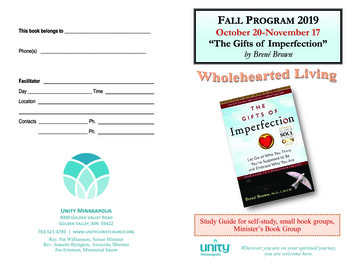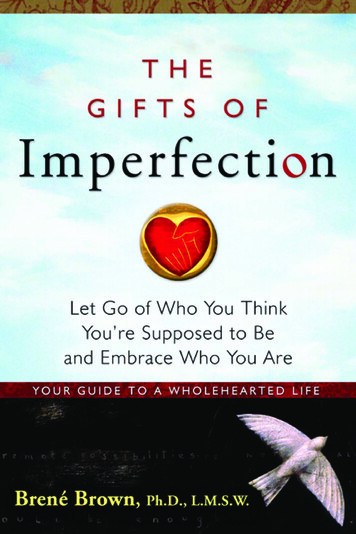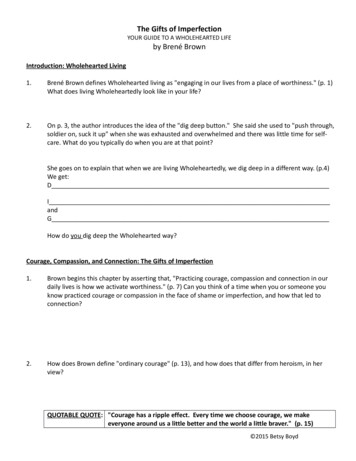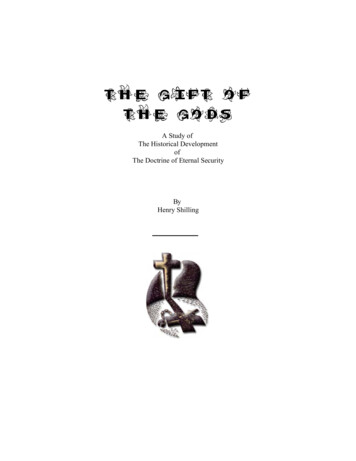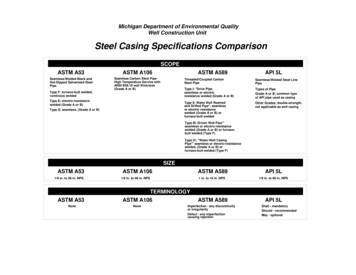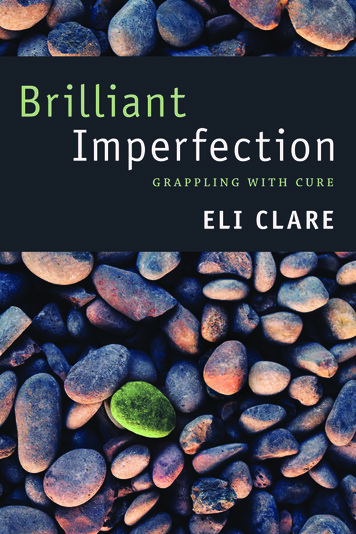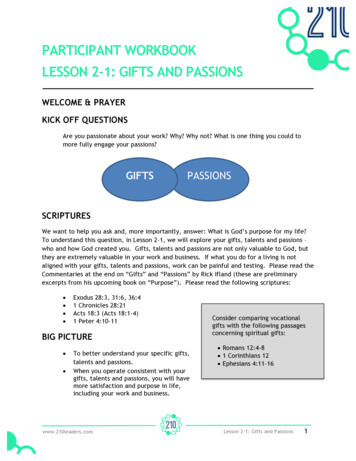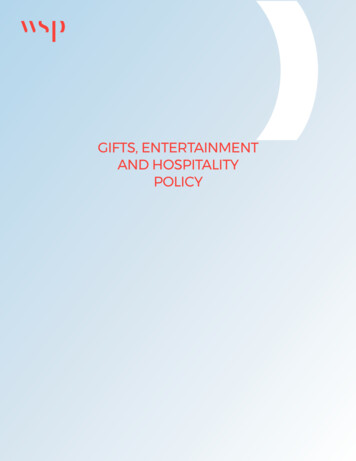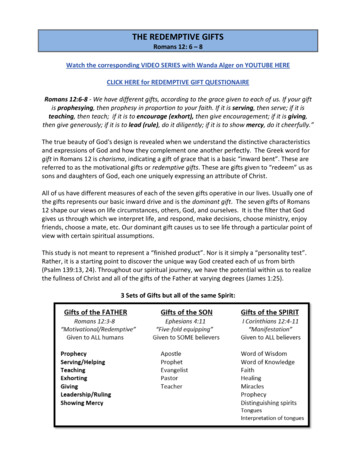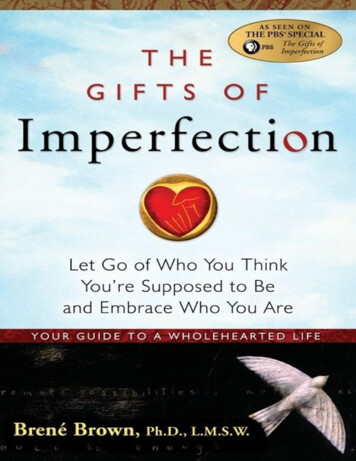
Transcription
THEGIFTS OFImperfection
THEGIFTS OFImperfectionLet Go of Who You Think You’re Supposedto Be and Embrace Who You Areby Brené Brown, Ph.D., L.M.S.W.
HazeldenCenter City, M innesota 55012hazelden.org 2010 by Brené BrownAll rights reserved. Published 2010Printed in the U nited States of AmericaNo part of this publication may be reproduced, stored in a retrieval system, or transmitted in any form or by any means—electronic, mechanical, photocopying, recording, scanning, or otherwise—without the express written permission of the publisher. Failure to comply withthese terms may expose you to legal action and damages for copyright infringement.Library of Congress Cataloging-in-Publication DataBrown, C. BrenéThe gifts of imperfection : let go of who you think you’re supposed to be and embrace who you are / by Brené Brown.p. cm.Includes bibliographical references.ISBN 978-1-59285-849-1 (softcover)ISBN 978-1-59285-989-4 (eBook )1. Self-acceptance. 2. Self-esteem. I. Title.BF575.S37B76 2010158—dc222010016989Editor’s noteThe names, details, and circumstances may have been changed to protect the privacy of those mentioned in this publication.This publication is not intended as a substitute for the advice of health care professionals.13 12 11 10 1 2 3 4 5 6Cover design by David SpohnCover illustrations by Nicholas WiltonInterior design and typesetting by Kinne Design
To Steve, Ellen, and Charlie.I love you with my whole heart.
contentsPrefaceAcknowledgmentsIntroduction: Wholehearted LivingCourage, Compassion, and Connection: The Gifts of ImperfectionExploring the Power of Love, Belonging, and Being EnoughThe Things That Get in the WayGuidepost #1Cultivating Authenticity:Letting Go of What People ThinkGuidepost #2Cultivating Self-Compassion:Letting Go of PerfectionismGuidepost #3Cultivating a Resilient Spirit:Letting Go of Numbing and PowerlessnessGuidepost #4Cultivating Gratitude and Joy:Letting Go of Scarcity and Fear of the DarkGuidepost #5Cultivating Intuition and Trusting Faith:Letting Go of the Need for CertaintyGuidepost #6Cultivating Creativity:Letting Go of ComparisonGuidepost #7Cultivating Play and Rest:Letting Go of Exhaustion as a Status Symbol and Productivity as Self-WorthGuidepost #8Cultivating Calm and Stillness:Letting Go of Anxiety as a Lifestyle
Guidepost #9Cultivating Meaningful Work:Letting Go of Self-Doubt and “Supposed To”Guidepost #10Cultivating Laughter, Song, and Dance:Letting Go of Being Cool and “Always in Control”Final ThoughtsAbout the Research Process: For Thrill-Seekers and Methodology JunkiesNotesAbout the Author
prefaceOwning our story and loving ourselves through that process is the bravest thing that we will ever do.Once you see a pattern, you can’t un-see it. Trust me, I’ve tried. But when the same truth keepsrepeating itself, it’s hard to pretend that it’s just a coincidence. For example, no matter how hard I tryto convince myself that I can function on six hours of sleep, anything less than eight hours leaves meimpatient, anxious, and foraging for carbohydrates. It’s a pattern. I also have a terrible procrastinationpattern: I always put off writing by reorganizing my entire house and spending way too much timeand money buying office supplies and organizing systems. Every single time.One reason it’s impossible to un-see trends is that our minds are engineered to seek out patternsand to assign meaning to them. Humans are a meaning-making species. And, for better or worse, mymind is actually fine-tuned to do this. I spent years training for it, and now it’s how I make my living.As a researcher, I observe human behavior so I can identify and name the subtle connections,relationships, and patterns that help us make meaning of our thoughts, behaviors, and feelings.I love what I do. Pattern hunting is wonderful work and, in fact, throughout my career, my attemptsat un-seeing were strictly reserved for my personal life and those humbling vulnerabilities that Iloved to deny. That all changed in November 2006, when the research that fills these pages smackedme upside the head. For the first time in my career, I was desperate to un-see my own research.Up until that point, I had dedicated my career to studying difficult emotions like shame, fear, andvulnerability. I had written academic pieces on shame, developed a shame-resilience curriculum formental health and addictions professionals, and written a book about shame resilience called IThought It Was Just Me.1In the process of collecting thousands of stories from diverse men and women who lived all overthe country—ranging in age from eighteen to eighty-seven—I saw new patterns that I wanted to knowmore about. Yes, we all struggle with shame and the fear of not being enough. And, yes, many of usare afraid to let our true selves be seen and known. But in this huge mound of data there was alsostory after story of men and women who were living these amazing and inspiring lives.I heard stories about the power of embracing imperfection and vulnerability. I learned about theinextricable connection between joy and gratitude, and how things that I take for granted, like rest andplay, are as vital to our health as nutrition and exercise. These research participants trustedthemselves, and they talked about authenticity and love and belonging in a way that was completelynew to me.I wanted to look at these stories as a whole, so I grabbed a file and a Sharpie and wrote the firstword that came to my mind on the tab: Wholehearted. I wasn’t sure what it meant yet, but I knew thatthese stories were about people living and loving with their whole hearts.I had a lot of questions about Wholeheartedness. What did these folks value? How did they createall of this resilience in their lives? What were their main concerns and how did they resolve oraddress them? Can anyone create a Wholehearted life? What does it take to cultivate what we need?What gets in the way?As I started analyzing the stories and looking for re-occurring themes, I realized that the patterns
generally fell into one of two columns; for simplicity sake, I first labeled these Do and Don’t. The Docolumn was brimming with words like worthiness, rest, play, trust, faith, intuition, hope, authenticity,love, belonging, joy, gratitude, and creativity. The Don’t column was dripping with words likeperfection, numbing, certainty, exhaustion, self-sufficiency, being cool, fitting in, judgment, andscarcity.I gasped the first time I stepped back from the poster paper and took it all in. It was the worst kindof sticker shock. I remember mumbling, “No. No. No. How can this be?”Even though I wrote the lists, I was shocked to read them. When I code data, I go into deepresearcher mode. My only focus is on accurately capturing what I heard in the stories. I don’t thinkabout how I would say something, only how the research participants said it. I don’t think about whatan experience would mean to me, only what it meant to the person who told me about it.I sat in the red chair at my breakfast room table and stared at these two lists for a very long time.My eyes wandered up and down and across. I remember at one point I was actually sitting there withtears in my eyes and with my hand across my mouth, like someone had just delivered bad news.And, in fact, it was bad news. I thought I’d find that Wholehearted people were just like me anddoing all of the same things I was doing: working hard, following the rules, doing it until I got itright, always trying to know myself better, raising my kids exactly by the books After studying tough topics like shame for a decade, I truly believed that I deserved confirmationthat I was “living right.”But here’s the tough lesson that I learned that day (and every day since):How much we know and understand ourselves is critically important, but there is something that is even more essential to living a Wholehearted life: loving ourselves.Knowledge is important, but only if we’re being kind and gentle with ourselves as we work todiscover who we are. Wholeheartedness is as much about embracing our tenderness and vulnerabilityas it is about developing knowledge and claiming power.And perhaps the most painful lesson of that day hit me so hard that it took my breath away: It wasclear from the data that we cannot give our children what we don’t have. Where we are on ourjourney of living and loving with our whole hearts is a much stronger indicator of parenting successthan anything we can learn from how-to books.This journey is equal parts heart work and head work, and as I sat there on that dreary Novemberday, it was clear to me that I was lacking in my own heart work.I finally stood up, grabbed my marker off the table, drew a line under the Don’t list, and then wrotethe word me under the line. My struggles seemed to be perfectly characterized by the sum total of thelist.I folded my arms tightly across my chest, sunk deep down into my chair, and thought, This is justgreat. I’m living straight down the shit list.I walked around the house for about twenty minutes trying to un-see and undo everything that hadjust unfolded, but I couldn’t make the words go away. I couldn’t go back, so I did the next best thing: Ifolded all of the poster sheets into neat squares and tucked then into a Rubbermaid tub that fit nicelyunder my bed, next to my Christmas wrap. I wouldn’t open that tub again until March of 2008.Next, I got myself a really good therapist and began a year of serious soul work that would foreverchange my life. Diana, my therapist, and I still laugh about my first visit. Diana, who is a therapist tomany therapists, started with the requisite, “So what’s going on?” I pulled out the Do list and matterof-factly said, “I need more of the things on this list. Some specific tips and tools would be helpful.Nothing deep. No childhood crap or anything.”
It was a long year. I lovingly refer to it on my blog as the 2007 Breakdown Spiritual Awakening. Itfelt like a textbook breakdown to me, but Diana called it a spiritual awakening. I think we were bothright. In fact, I’m starting to question if you can have one without the other.Of course, it’s not a coincidence that this unraveling happened in November 2006. The stars wereperfectly aligned for a breakdown: I was raw from being newly sugar and flour free, I was days awayfrom my birthday (always a contemplative time for me), I was burned out from work, and I was righton the cusp of my midlife unraveling.People may call what happens at midlife “a crisis,” but it’s not. It’s an unraveling—a time when youfeel a desperate pull to live the life you want to live, not the one you’re “supposed” to live. Theunraveling is a time when you are challenged by the universe to let go of who you think you aresupposed to be and to embrace who you are.Midlife is certainly one of the great unraveling journeys, but there are others that happen to us overthe course of our lives:marriagedivorcebecoming a parentrecoverymovingan empty nestretiringexperiencing loss or traumaworking in a soul-sucking jobThe universe is not short on wake-up calls. We’re just quick to hit the snooze button.As it turned out, the work I had to do was messy and deep. I slogged through it until one day,exhausted and with mud still wet and dripping off of my traveling shoes, I realized, “Oh, my God. Ifeel different. I feel joyful and real. I’m still afraid, but I also feel really brave. Something haschanged—I can feel it in my bones.”I was healthier, more joyful, and more grateful than I had ever felt. I felt calmer and grounded, andsignificantly less anxious. I had rekindled my creative life, reconnected with my family and friends ina new way, and most important, felt truly comfortable in my own skin for the first time in my life.I learned how to worry more about how I felt and less about “what people might think.” I wassetting new boundaries and began to let go of my need to please, perform, and perfect. I started sayingno rather than sure (and being resentful and pissed off later). I began to say “Oh, hell yes!” rather than“Sounds fun, but I have lots of work to do” or “I’ll do that when I’m (thinner, less busy,better prepared).”As I worked through my own Wholehearted journey with Diana, I read close to forty books,including every spiritual awakening memoir I could get my hands on. They were incredibly helpfulguides, but I still craved a guidebook that could offer inspiration, resources, and basically serve as asoul traveler ’s companion of sorts.One day, as I stared at the tall pile of books precariously stacked on my nightstand, it hit me! I wantto tell this story in a memoir. I’ll tell the story of how a cynical, smart-ass academic became every bitof the stereotype that she spent her entire adult life ridiculing. I’ll fess up about how I became themiddle-aged, recovering, health-conscious, creative, touchy-feely spirituality-seeker who spends dayscontemplating things like grace, love, gratitude, creativity, authenticity, and is happier than I imagined
possible. I’ll call it Wholehearted.I also remember thinking, Before I write the memoir, I need to use this research to write aguidebook on Wholehearted living! By mid-2008, I had filled three huge tubs with notebooks,journals, and mounds of data. I had also done countless hours of new research. I had everything Ineeded, including a passionate desire to write the book that you’re holding in your hands.On that fateful November day when the list appeared and I sunk into the realization that I wasn’tliving and loving with my whole heart, I wasn’t totally convinced. Seeing the list wasn’t enough tofully believe in it. I had to dig very deep and make the conscious choice to believe to believe inmyself and the possibility of living a different life. A lot of questioning, countless tears, and a hugecollection of joyful moments later, believing has helped me see.I now see how owning our story and loving ourselves through that process is the bravest thing thatwe will ever do.I now see that cultivating a Wholehearted life is not like trying to reach a destination. It’s likewalking toward a star in the sky. We never really arrive, but we certainly know that we’re heading inthe right direction.I now see how gifts like courage, compassion, and connection only work when they are exercised.Every day.I now see how the work of cultivating and letting go that shows up in the ten guideposts is not “todo list” material. It’s not something we accomplish or acquire and then check off our list. It’s lifework. It’s soul work.For me, believing was seeing. I believed first, and only then I was able to see how we can trulychange ourselves, our families, and our communities. We just have to find the courage to live andlove with our whole hearts. It’s an honor to make this journey with you!
acknowledgmentsDeepest gratitude to:Patricia Broat, Karen Casey, Karen Chernyaev, Kate Croteau, April Dahl, Ronda Dearing, Sid Farrar,Margarita Flores, Karen Holmes, Charles Kiley, Polly Koch, Shawn Ostrowski, Cole Schweikhardt,Joanie Shoemaker, Dave Spohn, Diana Storms, Ashley Thill, Sue Thill, Alison Vandenberg, YolandaVillarreal, Jo-Lynne Worley, my Move-a-Body friends, my family, and the Lovebombers
Wholehearted living is about engaging in our lives from a place of worthiness. It means cultivatingthe courage, compassion, and connection to wake up in the morning and think, No matter what getsdone and how much is left undone, I am enough. It’s going to bed at night thinking, Yes, I am imperfectand vulnerable and sometimes afraid, but that doesn’t change the truth that I am also brave andworthy of love and belonging.The JourneyWholehearted living is not a onetime choice. It is a process. In fact, I believe it’s the journey of alifetime. My goal is to bring awareness and clarity to the constellation of choices that lead toWholeheartedness and to share what I’ve learned from many, many people who have dedicatedthemselves to living and loving with their whole hearts.Before embarking on any journey, including this one, it’s important to talk about what we need tobring along. What does it take to live and love from a place of worthiness? How do we embraceimperfection? How do we cultivate what we need and let go of the things that are holding us back?The answers to all of these questions are courage, compassion, and connection—the tools we need towork our way through our journey.If you’re thinking, Great. I just need to be a superhero to fight perfectionism, I understand.Courage, compassion, and connection seem like big, lofty ideals. But in reality, they are dailypractices that, when exercised enough, become these incredible gifts in our lives. And the good newsis that our vulnerabilities are what force us to call upon these amazing tools. Because we’re humanand so beautifully imperfect, we get to practice using our tools on a daily basis. In this way, courage,compassion, and connection become gifts—the gifts of imperfection.Here’s what you’ll find in the pages that follow. In the first chapter, I explain what I’ve learnedabout courage, compassion, and connection and how they are truly the tools for developingworthiness.Once we get some clarity about the tools that we’re going to use on this journey, in the next chapterwe move to the heart of the matter: love, belonging, and worthiness. I answer some of the mostdifficult questions of my career: What is love? Can we love someone and betray them? Why does ourconstant need to fit in sabotage real belonging? Can we love the people in our lives, like our partnersand children, more than we love ourselves? How do we define worthiness, and why do we so oftenend up hustling for it rather than believing in it?
We encounter obstacles on every journey we make; the Wholehearted journey is no exception. Inthe next chapter, we’ll explore what I’ve found to be the greatest barriers to living and loving withour whole hearts and how we can develop effective strategies to move through the barriers and tocultivate resilience.From there, we’ll explore the ten guideposts for the Wholehearted journey, daily practices thatprovide direction for our journey. There’s one chapter for each guidepost, and each chapter isillustrated with stories, definitions, quotes, and ideas for making deliberate and inspired choices aboutthe way we live and love.Defining MomentsThis book is full of big-concept words such as love, belonging, and authenticity. I think it’s criticallyimportant to define the gauzy words that are tossed around every day but rarely explained. And I thinkgood definitions should be accessible and actionable. I’ve tried to define these words in a way thatwill help us unpack the term and explore the pieces. When we dig down past the feel-good words andexcavate the daily activities and experiences that put the heart in Wholehearted living, we can see howpeople define the concepts that drive their actions, beliefs, and emotions.For example, when the research participants talked about a concept such as love, I was careful todefine it as they experienced it. Sometimes that required developing new definitions (like I actuallydid with love and many other words). Other times, when I started looking around in the existingliterature, I found definitions that captured the spirit of the participants’ experiences. A good exampleof this is play. Play is an essential component to Wholehearted living, and when I researched thetopic, I discovered the amazing work of Dr. Stuart Brown.1 So, rather than creating a new definition, Ireference his work because it accurately reflects what I learned in the research.I realize that definitions spark controversy and disagreement, but I’m okay with that. I’d rather wedebate the meaning of words that are important to us than not discuss them at all. We need commonlanguage to help us create awareness and understanding, which is essential to Wholehearted living.Digging DeepIn early 2008, when my blog was still pretty new, I wrote a post about breaking my “dig-deep” button.You know the dig-deep button, right? It’s the button that you rely on when you’re too bone-tired to getup one more time in the middle of the night or to do one more load of throw-up-diarrhea laundry orto catch one more plane or to return one more call or to please/perform/perfect the way younormally do even when you just want to flip someone off and hide under the covers.The dig-deep button is a secret level of pushing through when we’re exhausted and overwhelmed,and when there’s too much to do and too little time for self-care.In my blog post, I explained how I had decided not to fix my dig-deep button. I made a promise tomyself that when I felt emotionally, physically, and spiritually done, I’d try slowing down rather thanrelying on my old standbys: pushing through, soldiering on, and sucking it up.It worked for a while, but I missed my button. I missed having something to turn to when I wasdepleted and down. I needed a tool to help me dig my way out. So, I turned back to my research to seeif I could find a way to dig that was more consistent with Wholehearted living. Maybe there wassomething better than just sucking it up.Here’s what I found: Men and women who live Wholeheartedly do indeed DIG Deep. They just do
it in a different way. When they’re exhausted and overwhelmed, they getDeliberate in their thoughts and behaviors through prayer, meditation, or simply setting their intentions;Inspired to mak e new and different choices;Going. They tak e action.Since I made that discovery, I’ve been DIGging Deep the new way, and it’s been pretty amazing.One example happened just recently when I was lost in an Internet fog. Rather than working, I was justlulling myself into a haze by mindlessly playing on Facebook and piddling on the computer. It wasneither relaxing nor productive—it was just a giant time and energy suck.I tried the new DIG Deep—get deliberate, inspired, and going. I told myself, “If you need to refueland losing yourself online is fun and relaxing, then do it. If not, do something deliberately relaxing.Find something inspiring to do rather than something soul-sucking. Then, last but not least, get up anddo it!” I closed my laptop, said a little prayer to remind myself to be self-compassionate, and watcheda movie that had been sitting in a Netflix envelope on my desk for over a month. It was exactly what Ineeded.It wasn’t the old Dig Deep—the pushing through. I didn’t force myself to start working or to dosomething productive. Rather, I prayerfully, intentionally, and thoughtfully did something restorative.Each guidepost has a DIG Deep section to help us start thinking about how we get deliberate andinspired about our choices, and how we take action. I share my personal DIG Deep strategies with youand I encourage you to come up with your own. These new strategies have been so much moreeffective than the old “pushing through.”What I Hope to ContributeThis book is full of powerful topics such as self-compassion, acceptance, and gratitude. I’m not thefirst to talk about these subjects, and I’m certainly not the smartest researcher or the most talentedwriter. I am, however, the first to explain how these topics work individually and together to cultivateWholehearted living. And, maybe more important, I’m certainly the first person to come at thesetopics from the perspective of someone who has spent years studying shame and fear.I can’t tell you how many times I wanted to give up my research on shame. It’s extremely difficultto dedicate your career to studying topics that make people squeamish. On several occasions I’veliterally thrown my hands up and said, “I quit. It’s too hard. There are so many cool things to study. Iwant out of this!” I didn’t choose to study shame and fear; the research chose me.Now I know why. It was what I needed—professionally and personally—to prepare for this workon Wholeheartedness. We can talk about courage and love and compassion until we sound like agreeting card store, but unless we’re willing to have an honest conversation about what gets in theway of putting these into practice in our daily lives, we will never change. Never, ever.Courage sounds great, but we need to talk about how it requires us to let go of what other peoplethink, and for most of us, that’s scary. Compassion is something we all want, but are we willing tolook at why boundary-setting and saying no is a critical component of compassion? Are we willing tosay no, even if we’re disappointing someone? Belonging is an essential component of Wholeheartedliving, but first we have to cultivate self-acceptance—why is this such a struggle?Before I start writing, I always ask myself, “Why is this book worth writing? What’s thecontribution that I’m hoping to make?” Ironically, I think the most valuable contribution that I canmake to the ongoing discussions about love, belonging, and worthiness stems from my experiencesas a shame researcher.Coming at this work with a full understanding of how the shame tapes and gremlins keep us feeling
afraid and small allows me to do more than present great ideas; this perspective helps me share realstrategies for changing our lives. If we want to know why we’re all so afraid to let our true selves beseen and known, we have to understand the power of shame and fear. If we can’t stand up to the nevergood enough and who do you think you are? we can’t move forward.I only wish that during those desperate and defeated moments of my past, when I was knee-deep inshame research, I could have known what I know now. If I could go back and whisper in my ear, I’dtell myself the same thing that I’ll tell you as we begin this journey:Owning our story can be hard but not nearly as difficult as spending our lives running from it. Embracing our vulnerabilities is risky but not nearly as dangerous as giving up on love and belonging and joy—the experiences that make us the mostvulnerable. Only when we are brave enough to explore the darkness will we discover the infinite power of our light.
Practicing courage, compassion, and connection in our daily lives is how we cultivate worthiness.The key word is practice. Mary Daly, a theologian, writes, “Courage is like—it’s a habitus, a habit, avirtue: You get it by courageous acts. It’s like you learn to swim by swimming. You learn courage bycouraging.” The same is true for compassion and connection. We invite compassion into our liveswhen we act compassionately toward ourselves and others, and we feel connected in our lives whenwe reach out and connect.Before I define these concepts and talk about how they work, I want to show you how they worktogether in real life—as practices. This is a personal story about the courage to reach out, thecompassion that comes from saying, “I’ve been there,” and the connections that fuel our worthiness.The Gun-for-Hire Shame StormNot too long ago, the principal of a large public elementary school and the president of the school’sparent-teacher organization (PTO) invited me to speak to a group of parents about the relationshipbetween resilience and boundaries. I was in the process of collecting data about Wholeheartedparenting and schools at the time, so I was excited about the opportunity. I had no idea what I wasgetting myself into.The second I walked into the school auditorium, I felt this really strange vibe from the parents inthe audience. They almost seemed agitated.I asked the principal about it, and she just shrugged her shoulders and walked away. The PTOpresident didn’t have much to say about it either. I chalked it up to my nerves and tried to let it go.I was sitting in the front row when the principal introduced me. This is always a very awkwardexperience for me. Someone is running through a list of my accomplishments while I’m secretlytrying to stave off vomiting and talking myself out of running. Well, this introduction was beyondanything I had ever experienced.The principal was saying things like, “You might not like what you’re going to hear tonight, but weneed to listen for the sake of our children. Dr. Brown is here to transform our school and our lives!She’s going to set us straight whether we like it or not!”She was talking in this loud, aggressive voice that made her seem downright pissed off. I felt like Iwas being introduced for WWE WrestleMania. All we needed were the Jock Jams and a few strobelights.
In hindsight, I should have walked up to the podium and said, “I’m feeling very uncomfortable. I’mexcited to be here, but I’m certainly not here to set anyone straight. I also don’t want you to think thatI’m trying to transform your school in an hour. What’s going on?”But I didn’t. I just started talking in my vulnerable nt way. Well, the die had been cast. These parents were not receptive. Instead, I felt row after rowof people glaring at me.One man, who was sitting right up front, had his arms folded across his chest and his teeth clenchedso tightly that the veins in his neck were popping out. Every three or four minutes he’d shift in hisseat, roll his eyes, and sigh louder than I’ve ever heard anyone sigh. It was so loud that I’m barelycomfortable calling it a sigh. It was more like a humph! It was so bad that the people next to him werevisibly mortified by his behavior. They were still inexplicably unhappy with me, but he was makingthe entire evening unbearable for all of us.As an experienced teacher and group leader, I know how to handle these situations and amnormally comfortable doing so. When someone is being disruptive, you really only have twochoices: ignore him or take a break so that you can privately confront him about his inappropriatebehavior. I was so knocked off my game by this weird experience that I did the very worst thingpossible: I tried to impress him.I started talking louder and getting really animated. I quoted scary rese
Brown, C. Brené The gifts of imperfection : let go of who you think you’re supposed to be and embrace who you are / by Brené Brown. p. cm. Includes bibliographical references. ISBN 978-1-59285-849-1 (softcover) ISBN 978-1-59285-989-4 (eBook) 1. Self-acceptance. 2. Self-esteem. I. T
